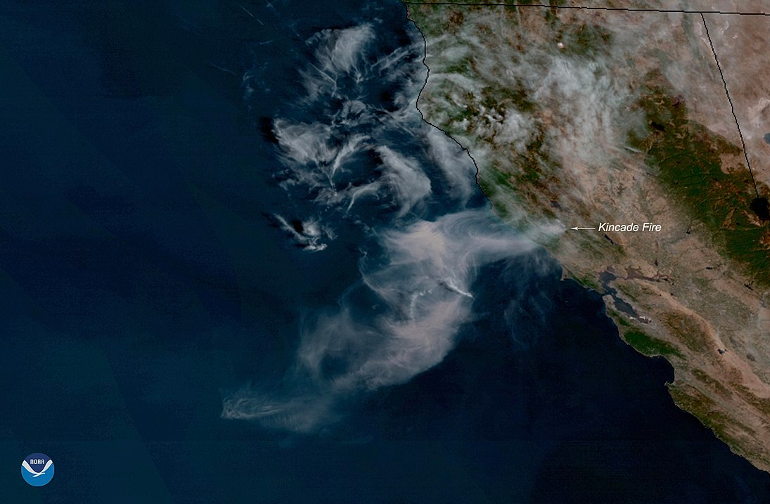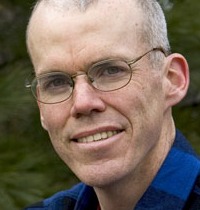As with so many things, Californians are going first where the rest of us will follow
Monday morning dawned smoky across much of California, and it dawned scary – over the weekend winds as high as a hundred miles an hour had whipped wildfires through forests and subdivisions.
It wasn’t the first time this had happened – indeed, it’s happened every year for the last three – and this time the flames were licking against communities destroyed in 2017. Reporters spoke to one family that had moved into their rebuilt home on Saturday, only to be immediately evacuated again.
The spectacle was cinematic: at one point, fire jumped the Carquinez Strait at the end of San Francisco Bay, shrouding the bridge on Interstate 80 in smoke and flame.
Even areas that didn’t actually burn felt the effects: Pacific Gas and Electric turned off power to millions, fearful that when the wind tore down its wires they would spark new conflagrations.
Three years in a row feels like – well, it starts to feel like the new, and impossible, normal. That’s what the local newspaper, the San Francisco Chronicle, implied this morning when, in the middle of its account of the inferno, it included the following sentence: the fires had “intensified fears that parts of California had become almost too dangerous to inhabit”. Read that again: the local paper is on record stating that part of the state is now so risky that its citizens might have to leave.
On the one hand, this comes as no real surprise. My most recent book, Falter, centered on the notion that the climate crisis was making large swaths of the world increasingly off-limits to humans. Cities in Asia and the Middle East where the temperature now reaches the upper 120s – levels so high that the human body can’t really cool itself; island nations (and Florida beaches) where each high tide washes through the living room or the streets; Arctic villages relocating because, with sea ice vanished, the ocean erodes the shore.
But California? California was always the world’s idea of paradise (until perhaps the city of that name burned last summer). Hollywood shaped our fantasies of the last century, and many of its movies were set in the Golden state. It’s where the Okies trudged when their climate turned vicious during the Dust Bowl years – “pastures of plenty”, Woody Guthrie called the green agricultural valleys. John Muir invented our grammar and rhetoric of wildness in the high Sierra (and modern environmentalism was born with the club he founded).
California is the Golden state, the land of ease. I was born there, and though I left young enough that my memories are suspect, I grew up listening to my parents’ stories. They had been newlyweds in the late 50s, living a block from the ocean in Manhattan Beach; when they got home from work they could walk to the sand for a game of volleyball. Date night was a mile or two up the Pacific Coast Highway to the Lighthouse, the jazz club where giants such as Gerry Mulligan showed up regularly, inventing the cool jazz that defined the place and time. Sunset magazine showcased a California aesthetic as breezy and informal as any on earth: the redwood deck, the cedar-shake roof, the suburban idyll among the eucalyptus and the pine. That is to say, precisely the kinds of homes that today are small piles of ash with only the kidney-shaped pool intact.
Truth be told, that California began to vanish fairly quickly, as orange groves turned into airplane factories and then tech meccas. The great voices of California in recent years – writers such as Mike Davis and Rebecca Solnit – chronicle the demise of much that was once idyllic in a wave of money, consumption, nimbyism, tax dodging, and corporate greed. The state’s been booming in recent years – it’s the world’s fifth biggest economy, bigger than the UK – but it’s also home to tent encampments of homeless people with no chance of paying rent. And it’s not just climate change that’s at fault: California has always had fires, and the state’s biggest utility, PG&E, is at this point as much an arsonist as electricity provider.
Still, it takes a force as great as the climate crisis to really – perhaps finally – tarnish Eden. In the last decade, the state has endured the deepest droughts ever measured, dry spells so intense that more than a hundred million trees died. A hundred million – and the scientists who counted them warned that their carcasses could “produce wildfires on a scale and of an intensity that California has never seen”. The drought has alternated with record downpours that have turned burned-over stretches into massive house-burying mudslides.
And so Californians – always shirtsleeved and cool – spend some of the year in face masks and much of it with a feeling of trepidation. As with so many things, they are going first where the rest of us will follow.






